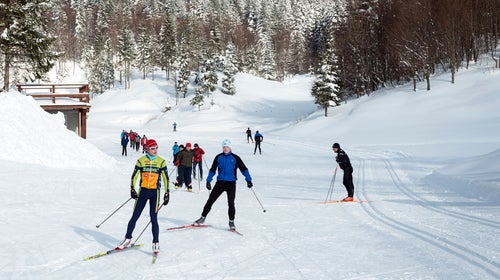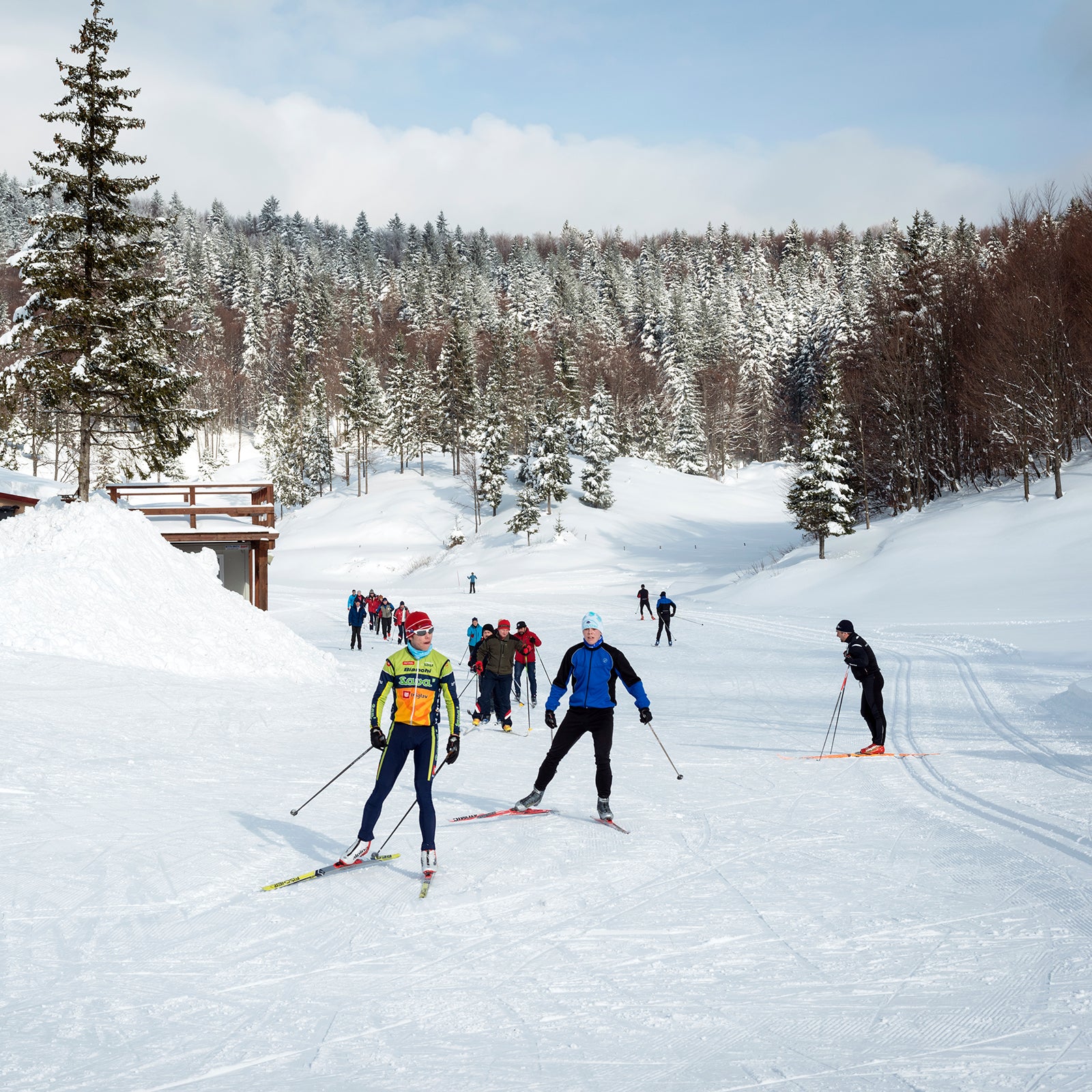If youÔÇÖve ventured into the sport of cross-country skiing,╠řyouÔÇÖve likely made the mistake of being hopelessly overdressed and underprepared. As if this╠řwerenÔÇÖt╠řalready the worldÔÇÖs hardest sport, youÔÇÖve weighed yourself down with parkas and snow pants, which inevitably wind up sweaty and unzipped, superfluous layers flapping in the wind. Symptoms╠řalso include drenched neck gaiters and oversize╠řfleece hats haphazardly stuffed into HotHands-filled pockets in a moment of desperation.
Yes,╠řcross-country skiing is hard. But the real issue is╠řthat youÔÇÖve dressed╠řyourself like youÔÇÖre going downhill, not up. To the uninitiated, this is an easy mistake to make. Even seasoned nordies are prone to overdressing sometimes.
After four years╠řas a professional nordic racer, IÔÇÖve amassed an armload of tricks that make a day on skinny skis much more enjoyable.
To start, drop any preconceived notions of what you think is cool in snow sports. Baggy jackets? Nope. Helmets and goggles? Nix. Nordic ski style is part cyclist, part speed racer, and undeniably Scandanavian, with pieces that are slim, simple, sleek, and highly functional. Since itÔÇÖs an aerobic sport like running, cross-country skiing layeringusually doesnÔÇÖt require too many clothes to keep you warm. The key is to wear just enough to avoid getting cold without winding up overheating on the first hill. Unless youÔÇÖre doing a lot of standing around (think: long, slow skis with lots of wildlife-viewing breaks and snack pit stops), you likely donÔÇÖt need more than two layers each on your top and bottom. You certainly do not need a heavy parka on top of fleecy layers. HereÔÇÖs what I recommend.
Choose Your Underthings Wisely
Generally speaking, start your layering from the inside and work outward. First, wear a pair of moisture-wicking undies that fully covers your butt. Most women and a few men will understand the distinction IÔÇÖm making here. Second, start your upper-body layering system with a light, tight tank top; this piece will warm your core while also keeping your arms free for movement. I borrow from the cyclistsÔÇÖ playbook and have a couple muscle-cut merino base layers on hand for extra chilly days. Add a long-sleeved base layer on top. For warm days, skip the tank and head straight for the base layer.
As for socks, youÔÇÖll want a pair thatÔÇÖs lightweight and not wooly. Heavy socks can retain moisture and cause blisters, even in the winter. YouÔÇÖll also want socks that rise above your ankles to keep out snow. As long as your feet are moving, your toes will be warm. If youÔÇÖll be doing significant standing around in your ski boots (cheering on the sidelines of a race or hanging out by a scenic view) or if itÔÇÖs particularly windy, boot covers╠řadd extra protection for your feet.
Layer Up Your Torso
Once you have your next-to-skin layers dialed, youÔÇÖll want to add a soft, breathable jacket, like one youÔÇÖd wear for running or fast-paced hiking. Great cross-country ski jackets are lightweight, stretchy, slightly wind blocking and moisture resistant, and have several pockets for snacks. If itÔÇÖs cold, don╠řa light vest as well. In fact, bring the vest along no matter what. In warm temperatures, you can wear it over your base layer without a jacket.
Wear Soft-Shell PantsÔÇöor No Pants!
For the legs, two layers will be enough. Start with a pair of light long undies (merino wool╠řis the best╠řbecause it resists stink) with either a pair of cross-country pants╠ř(more on those below) or a set of spandex tights.
Like jackets, good cross-country ski pants will be light and breathable. TheyÔÇÖre typically made of a stretchy soft-shell material╠řso that theyÔÇÖll wick moisture and move with you, and theyÔÇÖll have a fitted cut. Some might feature╠řslight wind resistance in front with a more breathable fabric╠řin back. I use╠řmine╠řfor camping during the summer and running in the fall.
But the fun thing about nordic skiing is that you actually donÔÇÖt have to wear pants. Nordorks love spandex. If you have a pair of running tights, those will work really well, especially in temperatures of around 30 degrees or more. (Just make sure that you wear them under your boots, not stretched over them, ya noob!)
Accessorize
Finish off your kit with a neck gaiter, hat, and gloves. Light Lycra neckies with no fleece are best, except on extra cold days when you might want additional╠řinsulation. Either way, they warm up the cold air around your face and in your throat, reducing your risk for lung burn, .
For your hat or headband, say it with me now:╠řÔÇťLighter is better.ÔÇŁ Careful, though. Your neighborhood ski shop might try to sell you something called a racing hat,╠řbecause youÔÇÖre buying all this other cool gear and clearly fit in with the nordies. These things are spandexy and tight, likely have your local╠řski-club logo screen-printed onto them, and have gained the nickname ÔÇťcondom capsÔÇŁ in the ski world for a reason. Best to avoid them╠řunless you want to look like a dork. .
Finally, opt for gloves over mittens. Unlike╠řdownhill skiing,╠řproper cross-country form requires you to grip your pole each time you plant it and then╠řrelease╠řthe grip as your follow through your stride, which means you need good dexterityÔÇöand mittens are like hot prisons for your fingers. I╠řalways have three pairs of gloves ready to deploy: a╠řlightweight pair, an insulated╠řpair, and one set of lobster gloves that offer the warmth of mitts without compromising too much fine motor control.
Pro tip: when shopping for gloves, look for a thoughtfully placed patch of fleece on the outside part of the thumb. ThatÔÇÖs a very important feature designed specially for nose wiping. YouÔÇÖre gonna need it.
Wear SunglassesÔÇöAny Sunglasses
This doesnÔÇÖt have to do with layering, but I cannot stress it enough: goggles are not sunglasses. are for shredding pow and protecting your face from the pounding downhill airflow. TheyÔÇÖre heavy, tight, and tend to fog up when you get hot. When worn without a helmet (which you also should not wear for nordic skiing), goggles╠řalso make you look like a Minion. Leave them at home.
When choosing what eyewear to bring, donÔÇÖt get too caught up in fashion. Any sunglasses will do, so long as they cover your eyes. The ideal option is a pair that has╠řinterchangeable lenses for different sun levels. Large-framed sunnies are very hot right now with the nordies. But wearing nothing is still better than wearing goggles.


